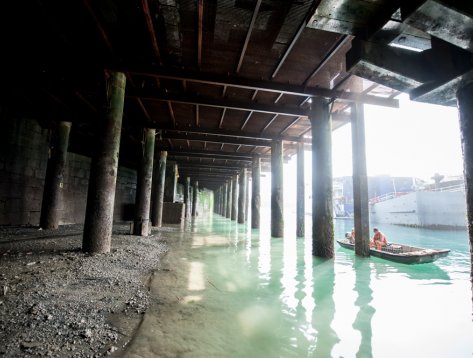Major concrete repairs & CP system for Island Infrastructure
Guernsey is one of the main Channel Islands situated off the coast of Normandy and has a population of 65,000. The marine berths are in the main town of St Peter Port and are an essential part of the Island’s infrastructure.
In order to ensure the berths were in good working condition, the port operators, the States of Guernsey, commissioned a review of Berths 4 and 6. It was recommended that as part of the overall berth refurbishment the reinforced concrete be repaired, an impressed current cathodic protection system installed to protect the reinforcement from corroding and the concrete encasement on the steel beams and columns removed and replaced.
Initially CRL worked with Guernsey Ports and their designers on an ECI basis to develop the design and methodology, as well as provide value engineering. This included:
-
- design of the ICCP system where the number of zones was rationalised and simplified producing savings. The main cable routing was originally planned to be in ducts placed behind the dock wall that would have required extensive excavation which would have been highly disruptive to the port. CRL developed a hanging cable tray solution beneath the berth that avoided the disruption, logistical and programme issues as well as potential ground risks,
- design for the extensive repairs sequence that avoided the need for any temporary works, and
- design of an access cut out through the deck, to allow access underneath the Berth if boats were docked up.
The works were accessed using a steel frame structure supported from brackets attached to the columns. The repairs were cut out using hydrodemolition and repaired using flowable concrete which was pumped into shutters from the top of the Berth.
The Cathodic Protection design completed by CorroCiv divided the system into 30 anode zones. On berth 4, above the mid tide level 4,500 m2 of concrete was cathodically protected using an impressed current system utilising MMO titanium mesh and ribbon anodes. This was then covered with a sprayed overlay. Below the mid tide level, galvanic anodes were fixed to the columns to protect these areas, this often required the use of diving teams.
Other works carried out on the Berths included the installation of new Hi-Dacs and fender facing plates with the preparation and painting of the supporting fender steelwork, installation of a new water main beneath the berth and maintenance works to the adjacent piled wall.
The smaller Berth 6 was repaired using discrete anodes to protect the reinforcing, with the ICCP system being linked to the Main Berth 4 control units.
The contract provided some significant challenges for the CRL design and installation team. All specialist materials had to be shipped to the Island from the UK 100 miles away. The tidal range at 10m is one of the highest in the world so a steel fabricated deck was used to provide permanent access for the repair works to be undertaken. Throughout the contract period the Berths also had to remained in operation for the transportation of goods.





























